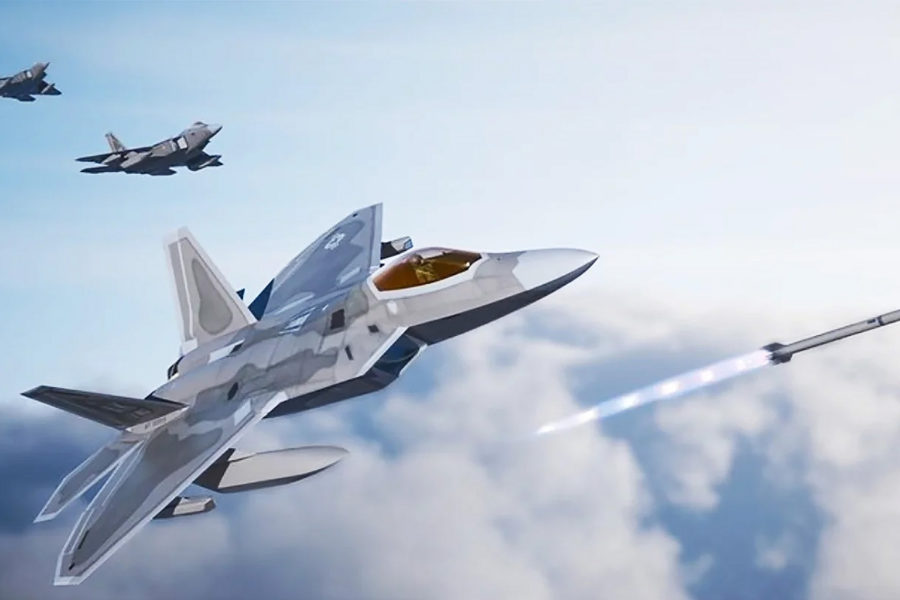The secretive AIM-260 Joint Advanced Tactical Missile will “hopefully” enter production this year, at an accelerated rate, Air Force Secretary Frank Kendall told the Senate Armed Services Committee on May 2. The JATM will also equip the Collaborative Combat Aircraft when the unmanned autonomous drones enter service, Chief of Staff Gen. Charles Q. Brown Jr. added.
“We’re entering production, hopefully, for JATM, the new air-to-air missile,” Kendall said at the congressional hearing. “And we’re going to be asking for funds to increase the size of that production line [and] increase capacity of our production line from what we originally had planned.”
The Air Force has not specified any production targets for JATM. The missile, which will serve the Air Force, Navy, and Marine Corps air fleets, was originally expected to have achieved initial operational capability in 2022. The Air Force is leading development on the weapon, which will first be deployed on the F-22 fighter but also has been described as equipping the Next Generation Air Dominance family of systems.
JATM will have significantly longer range than the Advanced Medium Range Air-to-Air Missile (AMRAAM), the Air Force’s primary air-to-air weapon which is it replacing. It will also likely have a multimode seeker, but details of its capability and performance are closely held.
Brown offered a new detail, however, in noting that JATM will also equip Collaborative Combat Aircraft—the unmanned, autonomous drones that will fly alongside manned platforms.
As the follow-on to AMRAAM, the JATM will be “an important aspect to support the Collaborative Combat Aircraft,” Brown told lawmakers.
The Air Force is still fleshing out what it wants the CCA program to be, but Kendall said he expects the drones to be in service by the end of the decade. However, the service does not have a roadmap for CCAs, just as it does not for several other other key modernization programs.
When asked why that is by Sen. Tammy Duckworth (D-Ill.), Kendall said the nature of the threat—China’s capabilities—is dynamic and changing rapidly. The Air Force Scientific Advisory Board is currently working on the Air Force is structured and “what our future posture might look like,” Kendall said, and the service will likely need to reorganize itself around new capabilities like CCAs and stealth tankers.
The service will also have to change “how we’re structured to do acquisition” to better keep up with a changing threat, as “we are not transitioning science and technologies [as] quickly … or efficiently” as needed into capabilities, Kendall noted.
The push to accelerate JATM production in particular is one of several ways the Air Force is seeking to expand its munitions capacity, Kendall said. The service is also requesting multiyear procurement authority for AMRAAM, the AGM-158 Joint Air-to-Surface Standoff Missile (JASSM), and the Long-Range Anti-Ship Weapon (LRASM).
The boost in AMRAAM procurement isn’t a sign of trouble in the JATM program, deputy chief of staff for plans and programs Lt. Gen. Richard Moore said at a Mitchell Institute for Aerospace Studies event in early April.
Indeed, the extra funding for munitions procurement—Kendall characterized it as roughly $1.5 billion—“will help facilitize … [and] increase the production rate, not only for AMRAAM” but JATM as well, Brown said May 2.
“We want to get to JATM as quickly as we possibly can,” Moore said in April, emphasizing that “once production gets underway, “we’ll get to quantity as fast as we can.”
The emphasis on increased and faster munitions procurement is driven by lessons from Ukraine, Moore and other officials have said. The rapid drawdown of U.S. weapons to provide to Ukraine—without the ability to swiftly replenish them for U.S. stocks—is driving the Pentagon to seek an increase in production. That means the AMRAAM, and any production line “that’s hot and is producing right now,” is seeing an increase, he said.

